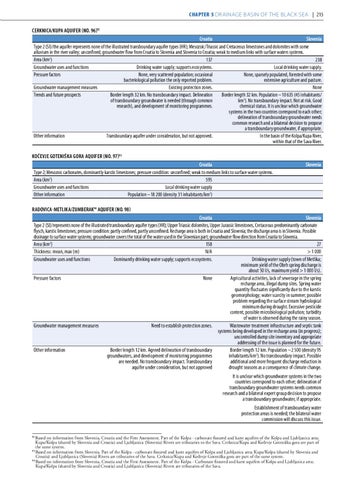Chapter 5 Drainage basin of the Black Sea | 215 Cerknica/Kupa aquifer (No. 96)92 Croatia Slovenia Type 2 (SI)/the aquifer represents none of the illustrated transboundary aquifer types (HR); Mesozoic/Triassic and Cretaceous limestones and dolomites with some alluvium in the river valley; unconfined; groundwater flow from Croatia to Slovenia and Slovenia to Croatia; weak to medium links with surface waters systems. Area (km2) 137 238 Groundwater uses and functions Drinking water supply; supports ecosystems. Local drinking water supply. Pressure factors None, very scattered population; occasional None, sparsely populated, forested with some bacteriological pollution the only reported problem. extensive agriculture and pasture. Groundwater management measures Existing protection zones. None Trends and future prospects Border length 32 km. No transboundary impact. Delineation Border length 32 km. Population ~10 635 (45 inhabitants/ of transboundary groundwater is needed (through common km2). No transboundary impact. Not at risk. Good research), and development of monitoring programmes. chemical status. It is unclear which groundwater systems in the two countries correspond to each other; delineation of transboundary groundwater needs common research and a bilateral decision to propose a transboundary groundwater, if appropriate. Other information Transboundary aquifer under consideration, but not approved. In the basin of the Kolpa/Kupa River, within that of the Sava River. Kočevje Goteniška gora aquifer (No. 97)93 Croatia Type 2; Mesozoic carbonates, dominantly karstic limestones; pressure condition: unconfined; weak to medium links to surface water systems. Area (km2) 595 Groundwater uses and functions Local drinking water supply Other information Population ~18 200 (density 31 inhabitants/km2)
Slovenia
Radovica-Metlika/Zumberak94 aquifer (No. 98) Croatia Slovenia Type 2 (SI)/represents none of the illustrated transboundary aquifer types (HR); Upper Triassic dolomites, Upper Jurassic limestones, Cretaceous predominantly carbonate flysch, karstic limestones; pressure condition: partly confined, partly unconfined. Recharge area is both in Croatia and Slovenia; the discharge area is in Slovenia. Possible drainage to surface water systems; groundwater covers the total of the water used in the Slovenian part; groundwater flow direction from Croatia to Slovenia. 158 27 Area (km2) Thickness: mean, max (m) N/A > 1 000 Groundwater uses and functions Dominantly drinking water supply; supports ecosystems. Drinking water supply (town of Metlika; minimum yield of the Obrh spring discharge is about 50 l/s, maximum yield > 1 000 l/s). Pressure factors None Agricultural activities, lack of sewerage in the spring recharge area, illegal dump sites. Spring water quantity fluctuates significantly due to the karstic geomorphology; water scarcity in summer; possible problem regarding the surface stream hydrological minimum during drought. Excessive pesticide content, possible microbiological pollution; turbidity of water is observed during the rainy season. Groundwater management measures Need to establish protection zones. Wastewater treatment infrastructure and septic tank systems being developed in the recharge area (in progress); uncontrolled dump site inventory and appropriate addressing of the issue is planned for the future. Other information Border length 12 km. Agreed delineation of transboundary Border length 12 km. Population ~2 500 (density 95 groundwaters, and development of monitoring programmes inhabitants/km2). No transboundary impact. Possible additional and more frequent discharge reduction in are needed. No transboundary impact. Transboundary drought seasons as a consequence of climate change. aquifer under consideration, but not approved It is unclear which groundwater systems in the two countries correspond to each other; delineation of transboundary groundwater systems needs common research and a bilateral expert group decision to propose a transboundary groundwater, if appropriate. Establishment of transboundary water protection areas is needed; the bilateral water commission will discuss this issue. Based on information from Slovenia, Croatia and the First Assessment. Part of the Kolpa - carbonate fissured and karst aquifers of the Kolpa and Ljubljanica area; Kupa/Kolpa (shared by Slovenia and Croatia) and Ljubljanica (Slovenia) Rivers are tributaries to the Sava. Cerknica/Kupa and Kočevje Goteniška gora are part of the same system. 93 Based on information from Slovenia. Part of the Kolpa - carbonate fissured and karst aquifers of Kolpa and Ljubljanica area; Kupa/Kolpa (shared by Slovenia and Croatia) and Ljubljanica (Slovenia) Rivers are tributaries of the Sava. Cerknica/Kupa and Kočevje Goteniška gora are part of the same system. 94 Based on information from Slovenia, Croatia and the First Assessment. Part of the Kolpa - Carbonate fissured and karst aquifers of Kolpa and Ljubljanica area; Kupa/Kolpa (shared by Slovenia and Croatia) and Ljubljanica (Slovenia) Rivers are tributaries of the Sava. 92
